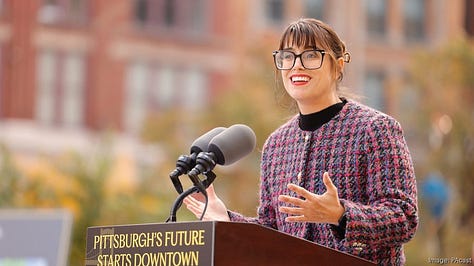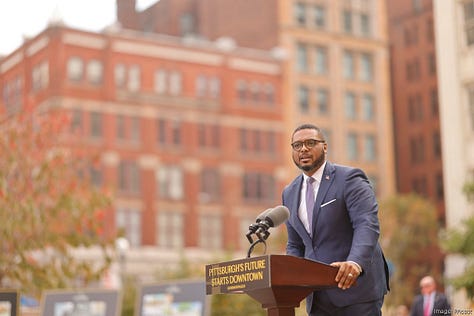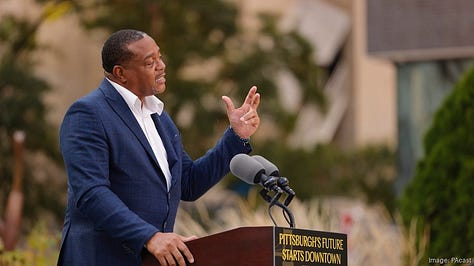The New Urban Order offers fresh ideas for post-pandemic cities. About 90 percent of my posts have a paywall and subscribers get extra content like this and this. Become a paying subscriber to support this work and read every word!






From my perch in Philadelphia, I was a bit gobsmacked when I heard the news last October that downtown Pittsburgh was getting $600 million in new investment. The money will go toward converting office buildings, creating and renovating public spaces, and improving the downtown’s public realm. Philadelphia and Pittsburgh have a bit of a sibling rivalry, and like my sons who can’t stand it when one gets something the other does not, the news left me wondering where’s Philly’s money?
The truth is that Philadelphia has been converting office buildings into apartments since the 1990s, encouraging tens of thousands of people to live downtown (which has only increased since the pandemic). Philly’s live-work-play downtown is often seen as a model for cities trying to escape the urban doom loop.
That said, Pittsburgh has done something Philadelphia and most other cities have not: united its leaders and funders around a vision for downtown. As Philadelphia struggles to figure out what to do with its Market East neighborhood now that a new stadium is out of the question, there are lessons in Pittsburgh’s fundraising, approach, and scale for Philly — and just about every other downtown.
Taking collective action
One of the most impressive things about this investment in Pittsburgh’s downtown is the number of investors and stakeholders involved in making this work happen. This is what collective action looks like. According to a PA.gov press release here’s how the $600 million came together:
As part of this effort, the Shapiro Administration is investing $62.6 million and the City of Pittsburgh is committing $22.1 million through the Urban Redevelopment Authority.
A broad coalition of private sector leaders and regional foundations have committed more than $40 million — and counting — in additional funding for this plan, including partners like BNY; Dollar Bank; Duquesne Light Company; Federated Hermes; FNB Bank; Giant Eagle; Highmark; Pitt Ohio; PNC Bank; PPG Industries; Reed Smith; Buchanan Ingersoll & Rooney PC; K&L Gates; the Buhl Foundation; the Eden Hall Foundation; the Heinz Endowments; the Hillman Foundation; the Jewish Healthcare Foundation; the Pittsburgh Steelers; the Pittsburgh Pirates; and the Pittsburgh Penguins. Those public and nonprofit dollars will help spur an additional $376.9 million in private sector investment from real estate developers Downtown.
When I spoke with Aaron Sukenik, Vice President, District Development at Pittsburgh Downtown Partnership, he noted the importance of the Allegheny Conference on Community Development in bringing local and regional leaders together. They’re the ones who have published the actual vision.
As Allegheny Conference CEO told the Pittsburgh Post-Gazette: “We all know we’re in an environment right now where there are so many issues and so much noise, and what you have to do is figure out what those three or four things are that everybody agrees upon… We’ve built trust that we would all be there and show up and that we could take action in a coordinated way.”
The Allegheny Conference serves a role somewhat akin to a Chamber of Commerce, but notably it emanated not from a concern about the business community, but for transportation and the environment. Several philanthropies also sit on the board. The result is that there’s skin in the game from local, county, state, corporate, and philanthropic sources and a sense that this is a community vision, not just that of the biggest power players.
Creating a multidimensional neighborhood
Pittsburgh’s downtown, like many throughout the country, was overindexed on commercial real estate before the pandemic. The core of this revitalization plan will be focused on commercial-to-residential conversions.
Sukenik estimated that while Pittsburgh has nearly 25 million square feet of office space, somewhere between 5 and 11 million square feet of office space can be converted. “That's further helped by the fact that we have an old downtown. We have a lot of Class B and C office in our downtown. It was built a hundred years ago, give or take 30 years,” Sukenik said.
Last fall, seven major conversions were announced, using $501.1 million in combined capital to create or preserve nearly 1,000 residential units. Nearly one third of the units are expected to be affordable to low- and moderate-income residents.
Of a city of 300,000, Pittsburgh has approximately 7,000 people living in its core downtown and double that in the greater downtown area. Adding more residents is key to a virtuous cycle: more residents bring foot traffic for retail, more eyes on the street to beat back social disorder, more employees who can walk to the office.
A Public Realm Suited to Post-Pandemic Trends
If it sounds like this is just about office conversions, a big focus of the downtown plan is on public spaces and improved streets.






